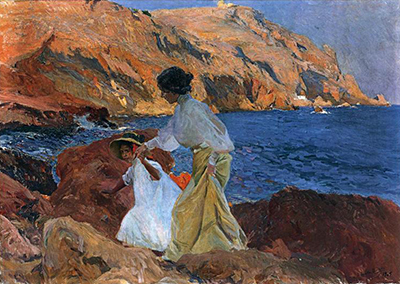This family portrait was created by Joaquin Sorolla in 1905 and features his wife and one of his daughters. The artist was immensely proud of his family and would regularly put them in his work, within a variety of locations and poses.
The majority of his portraits would attempt to look as natural as possible, rather than the more traditional styles where a formal pose is instructed by the artist. He did work in that way too, but much preferred to give the impression within his paintings that his subjects were entirely unaware of his presence and were simply going about their days as they normally would. In the example of Clotilde and Elena on the Rocks at Javea, we find the Sorollas out on a family excursion, though entirely suitably dressed for the purposes of this painting. The contrasting colours perhaps grab your attention first of all, with a deep blue for the waves, and a warm tone of orange for the rocky landscape on which mother and child cautiously tread. Elena herself is in a pure white outfit which adds a further avenue of contrast and Joaquin would regularly dress his children in white clothing when painting them.
Landscape painting would flourish in the second half of the 19th century, mainly due to the impact made by the French Impressionists and Sorolla would start to make use of some of their achievements by applying these techniques to the stunning Spanish landscape. He particularly liked to work on the beaches of Valencia but also took in other regions during his career, often combining several genres just as we can see here. There would be a strong use of shadowing which falls upon his family, whilst in the background brightness saturates the rockface. The waves look so real, as they should do from an artist who used the coast in so many of his paintings, and we can almost here the sounds of the water striking against the rock as Clotilde and Elena carefully meander their way towards a safer spot. Joaquin was essentially turning family memories from their various trips around Spain into some of the most celebrated artworks in his nation's artistic history.
Sorolla went through a period of social realism in which the same seascapes would be used to capture the lives of the working poor, with a common focus on the fishing industry of his beloved Valencia. Those would be heightened in emotion and even a little drama, whilst the same beaches would then accomodate children running playfully across the more shallow parts of the sea. He could successfully pull off both styles and then even move on to new challenges as he attempted to discover both what types of art he enjoyed painting, but crucially also what would actually prick the interest of patrons around the world. Ultimately, he eventually achieved financial security after discovering the right blend but today all of his oeuvre is rightly discussed and respected, rather than just what sold the most at the time.




